checking oil SKODA ROOMSTER 2012 1.G Owner's Manual
[x] Cancel search | Manufacturer: SKODA, Model Year: 2012, Model line: ROOMSTER, Model: SKODA ROOMSTER 2012 1.GPages: 194, PDF Size: 4.8 MB
Page 16 of 194
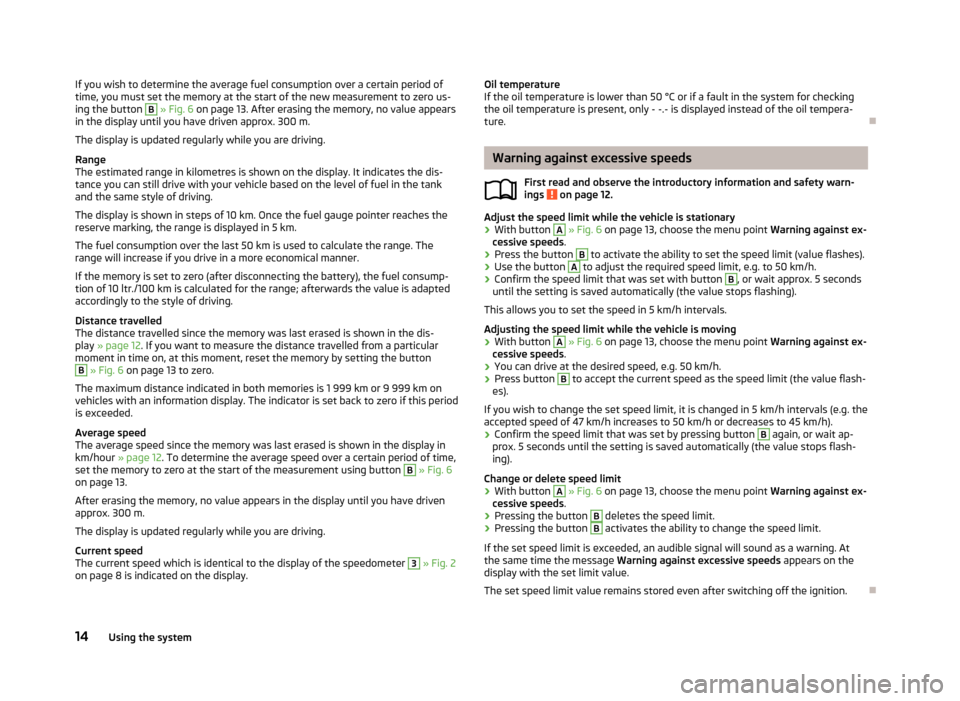
If you wish to determine the average fuel consumption over a certain period of
time, you must set the memory at the start of the new measurement to zero us-
ing the button
B
» Fig. 6 on page 13 . After erasing the memory, no value appears
in the display until you have driven approx. 300 m.
The display is updated regularly while you are driving.
Range
The estimated range in kilometres is shown on the display. It indicates the dis-
tance you can still drive with your vehicle based on the level of fuel in the tank
and the same style of driving.
The display is shown in steps of 10 km. Once the fuel gauge pointer reaches the
reserve marking, the range is displayed in 5 km.
The fuel consumption over the last 50 km is used to calculate the range. The
range will increase if you drive in a more economical manner.
If the memory is set to zero (after disconnecting the battery), the fuel consump-
tion of 10 ltr./100 km is calculated for the range; afterwards the value is adapted
accordingly to the style of driving.
Distance travelled
The distance travelled since the memory was last erased is shown in the dis-
play » page 12. If you want to measure the distance travelled from a particular
moment in time on, at this moment, reset the memory by setting the button B
» Fig. 6 on page 13 to zero.
The maximum distance indicated in both memories is 1
999 km or 9 999 km on
vehicles with an information display. The indicator is set back to zero if this period
is exceeded.
Average speed
The average speed since the memory was last erased is shown in the display in
km/hour » page 12 . To determine the average speed over a certain period of time,
set the memory to zero at the start of the measurement using button B
» Fig. 6
on page 13.
After erasing the memory, no value appears in the display until you have driven
approx. 300 m.
The display is updated regularly while you are driving.
Current speed
The current speed which is identical to the display of the speedometer 3
»
Fig. 2
on page 8 is indicated on the display. Oil temperature
If the oil temperature is lower than 50
°C or if a fault in the system for checking
the oil temperature is present, only - -.- is displayed instead of the oil tempera-
ture. Ð Warning against excessive speeds
First read and observe the introductory information and safety warn-
ings on page 12.
Adjust the speed limit while the vehicle is stationary
›
With button A
» Fig. 6 on page 13, choose the menu point
Warning against ex-
cessive speeds .
› Press the button B
to activate the ability to set the speed limit (value flashes).
› Use the button A
to adjust the required speed limit, e.g. to 50 km/h.
› Confirm the speed limit that was set with button B
, or wait approx. 5 seconds
until the setting is saved automatically (the value stops flashing).
This allows you to set the speed in 5 km/h intervals.
Adjusting the speed limit while the vehicle is moving
› With button A
» Fig. 6 on page 13, choose the menu point
Warning against ex-
cessive speeds .
› You can drive at the desired speed, e.g. 50 km/h.
› Press button B
to accept the current speed as the speed limit (the value flash-
es).
If you wish to change the set speed limit, it is changed in 5
km/h intervals (e.g. the
accepted speed of 47 km/h increases to 50 km/h or decreases to 45 km/h).
› Confirm the speed limit that was set by pressing button B
again, or wait ap-
prox. 5 seconds until the setting is saved automatically (the value stops flash-
ing).
Change or delete speed limit
› With button A
» Fig. 6 on page 13, choose the menu point
Warning against ex-
cessive speeds .
› Pressing the button B
deletes the speed limit.
› Pressing the button B
activates the ability to change the speed limit.
If the set speed limit is exceeded, an audible signal will sound as a warning. At
the same time the message Warning against excessive speeds appears on the
display with the set limit value.
The set speed limit value remains stored even after switching off the ignition. Ð
ä
14 Using the system
Page 20 of 194
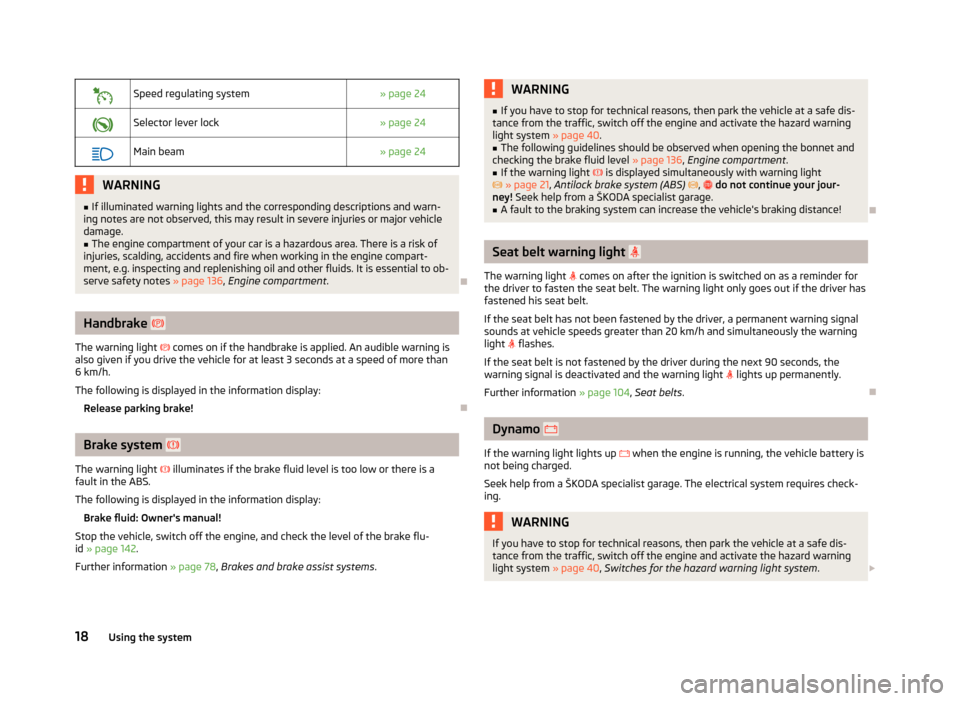
Speed regulating system
» page 24
Selector lever lock
» page 24
Main beam
» page 24WARNING
■ If illuminated warning lights and the corresponding descriptions and warn-
ing notes are not observed, this may result in severe injuries or major vehicle
damage.
■ The engine compartment of your car is a hazardous area. There is a risk of
injuries, scalding, accidents and fire when working in the engine compart-
ment, e.g. inspecting and replenishing oil and other fluids. It is essential to ob-
serve safety notes »
page 136, Engine compartment . ÐHandbrake
The warning light comes on if the handbrake is applied. An audible warning is
also given if you drive the vehicle for at least 3
seconds at a speed of more than
6 km/h.
The following is displayed in the information display:
Release parking brake! ÐBrake system
The warning light illuminates if the brake fluid level is too low or there is a
fault in the ABS.
The following is displayed in the information display:
Brake fluid: Owner's manual!
Stop the vehicle, switch off the engine, and check the level of the brake flu-
id » page 142.
Further information » page 78, Brakes and brake assist systems. WARNING
■ If you have to stop for technical reasons, then park the vehicle at a safe dis-
tance from the traffic, switch off the engine and activate the hazard warning
light system » page 40.
■ The following guidelines should be observed when opening the bonnet and
checking the brake fluid level » page 136, Engine compartment .
■ If the warning light is displayed simultaneously with warning light
» page 21, Antilock brake system (ABS) , do not continue your jour-
ney! Seek help from a ŠKODA specialist garage. ■ A fault to the braking system can increase the vehicle's braking distance! Ð Seat belt warning light
The warning light comes on after the ignition is switched on as a reminder for
the driver to fasten the seat belt. The warning light only goes out if the driver has
fastened his seat belt.
If the seat belt has not been fastened by the driver, a permanent warning signal
sounds at vehicle speeds greater than 20 km/h and simultaneously the warning
light flashes.
If the seat belt is not fastened by the driver during the next 90 seconds, the
warning signal is deactivated and the warning light lights up permanently.
Further information » page 104, Seat belts. Ð Dynamo
If the warning light lights up when the engine is running, the vehicle battery is
not being charged.
Seek help from a ŠKODA
specialist garage. The electrical system requires check-
ing. WARNING
If you have to stop for technical reasons, then park the vehicle at a safe dis-
tance from the traffic, switch off the engine and activate the hazard warning
light system » page 40, Switches for the hazard warning light system .£
18 Using the system
Page 21 of 194
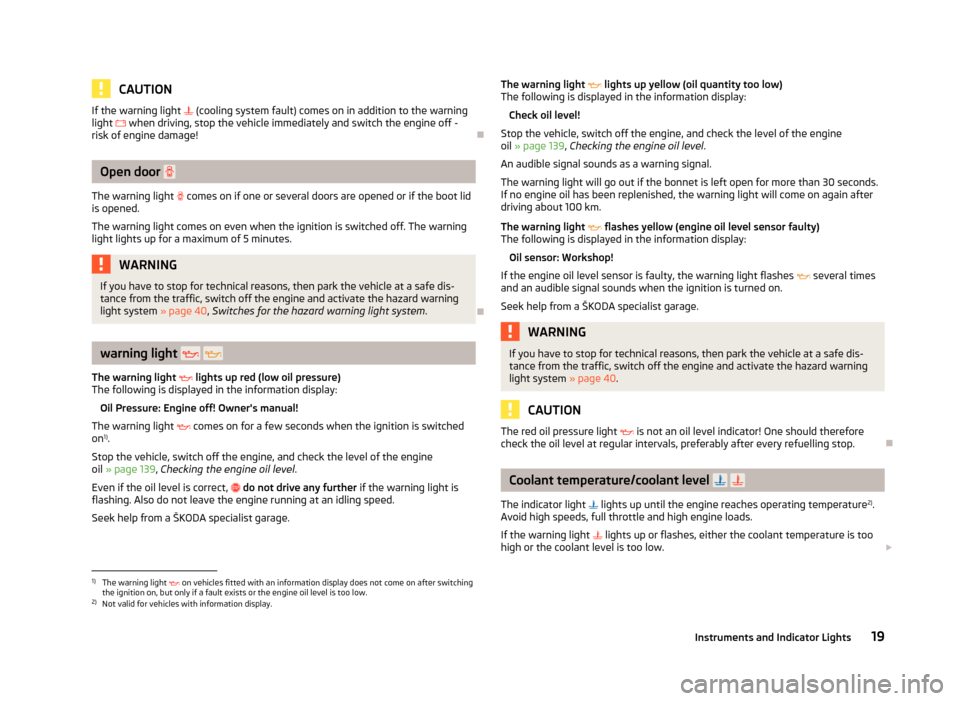
CAUTION
If the warning light (cooling system fault) comes on in addition to the warning
light when driving, stop the vehicle immediately and switch the engine off -
risk of engine damage! ÐOpen door
The warning light comes on if one or several doors are opened or if the boot lid
is opened.
The warning light comes on even when the ignition is switched off. The warning
light lights up for a maximum of 5 minutes. WARNING
If you have to stop for technical reasons, then park the vehicle at a safe dis-
tance from the traffic, switch off the engine and activate the hazard warning
light system » page 40, Switches for the hazard warning light system .Ð warning light
The warning light lights up red (low oil pressure)
The following is displayed in the information display:
Oil Pressure: Engine off! Owner's manual!
The warning light
comes on for a few seconds when the ignition is switched
on 1)
.
Stop the vehicle, switch off the engine, and check the level of the engine
oil » page 139, Checking the engine oil level .
Even if the oil level is correct, do not drive any further if the warning light is
flashing. Also do not leave the engine running at an idling speed.
Seek help from a ŠKODA specialist garage. The warning light
lights up yellow (oil quantity too low)
The following is displayed in the information display:
Check oil level!
Stop the vehicle, switch off the engine, and check the level of the engine
oil » page 139, Checking the engine oil level .
An audible signal sounds as a warning signal.
The warning light will go out if the bonnet is left open for more than 30 seconds.
If no engine oil has been replenished, the warning light will come on again after
driving about 100 km.
The warning light flashes yellow (engine oil level sensor faulty)
The following is displayed in the information display:
Oil sensor: Workshop!
If the engine oil level sensor is faulty, the warning light flashes several times
and an audible signal sounds when the ignition is turned on.
Seek help from a
ŠKODA specialist garage. WARNING
If you have to stop for technical reasons, then park the vehicle at a safe dis-
tance from the traffic, switch off the engine and activate the hazard warning
light system » page 40. CAUTION
The red oil pressure light is not an oil level indicator! One should therefore
check the oil level at regular intervals, preferably after every refuelling stop. Ð Coolant temperature/coolant level
The indicator light lights up until the engine reaches operating temperature 2)
.
Avoid high speeds, full throttle and high engine loads.
If the warning light lights up or flashes, either the coolant temperature is too
high or the coolant level is too low. £1)
The warning light on vehicles fitted with an information display does not come on after switching
the ignition on, but only if a fault exists or the engine oil level is too low.
2) Not valid for vehicles with information display.
19
Instruments and Indicator Lights
Page 121 of 194

Driving Tips
Driving and the Environment
The first 1 500 km
New engine
The engine has to be run in during the first 1 500 kilometres.
Up to 1 000 kilometres › Do not drive faster than 3/4 of the maximum speed of the gear in use, i.e. 3/4 of
the maximum permissible engine speed.
› No full throttle.
› Avoid high engine speeds.
› Do not tow a trailer.
From 1 000 up to 1
500 kilometres
› Gradually
increase the power output of the engine up to the full speed of the
gear engaged, i.e. up to the maximum permissible engine speed.
During the first operating hours the engine has higher internal friction than later
until all of the moving parts have harmonized. The driving style which you adopt
during the first approx.1
500 kilometres plays a decisive part in the success of
running in your car.
Never drive at unnecessarily high engine speeds even after the running-in period
is complete. The maximum permissible engine speed is marked by the start of the
red scale area of the revolutions counter. On vehicles fitted with a manual gear-
box, at the very latest shift up into the next gear when the red area is reached.
During acceleration (depressing the accelerator) exceptionally high engine
speeds are automatically reduced, yet the engine is not protected against too
high engine speeds which are caused by incorrectly shifting down the gears re-
sulting in a sudden increase of the engine speeds above the permitted maximum
revolutions which can lead to engine damage.
For a vehicle fitted with a manual gearbox the converse situation also applies: Do
not drive at an engine speed that is too low. Shift down a gear when the engine
is no longer running smoothly. Observe the recommended gear » page 11, Recom-
mended gear . CAUTION
All the speed and engine revolution figures apply only when the engine is at its
normal operating temperature. Never rev up a cold engine when the vehicle is
stationary or when driving in individual gears. For the sake of the environment
Not driving at unnecessarily high engine revolutions and shifting to a higher gear
as early as possible are ways to minimise fuel consumption and operating noise
levels and protects the environment. Ð New tyres
New tyres have to be “
run in” since they do not offer optimal grip at first. Drive
especially carefully for the first 500 km or so. Ð New brake pads
New brake pads initially do not provide full braking efficiency. The brake pads
must initially be “run in
”. Drive especially carefully for the first 200 km or so. Ð Catalytic converter
Proper operation of the emission control system (catalytic converter) is of major
significance for driving your vehicle in an environmentally conscious way.
The following guidelines must be observed: › Vehicles fitted with a petrol engine must always be refueled with unleaded pet-
rol » page 135, Unleaded petrol ;
› Do not pour too much oil into the engine
» page 139, Checking the engine oil
level;
› Do not switch off the ignition while driving.
If you drive your vehicle in a country in which unleaded petrol is not available, you
must have the catalytic converter replaced later when driving the vehicle into a
country in which use of a catalytic converter is mandatory. £
119
Driving and the Environment
Page 138 of 194
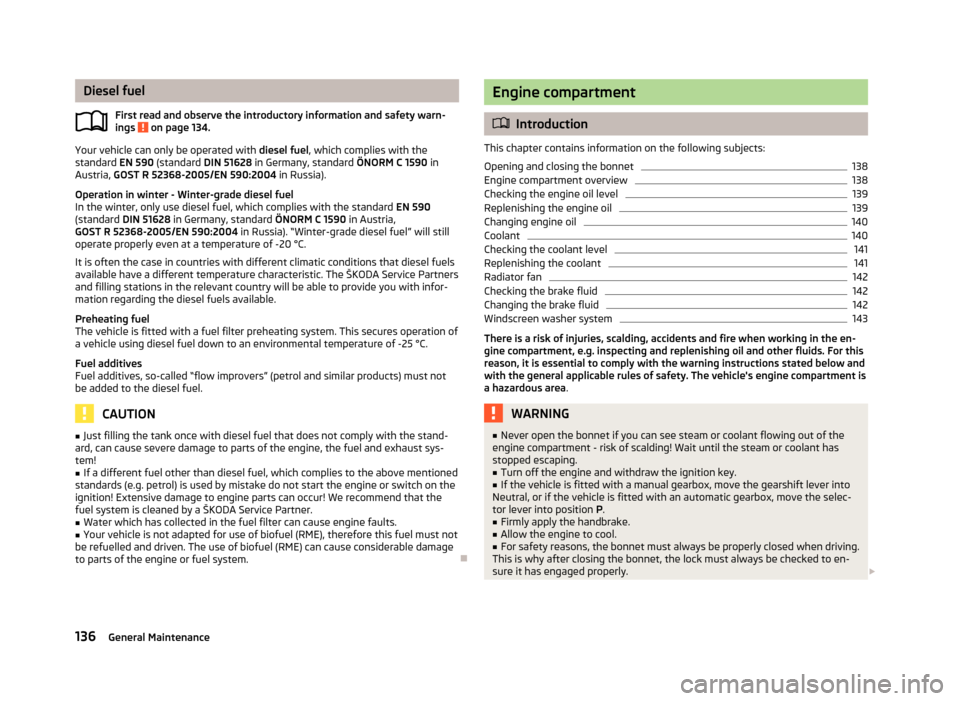
Diesel fuel
First read and observe the introductory information and safety warn-
ings on page 134.
Your vehicle can only be operated with
diesel fuel, which complies with the
standard EN
590 (standard DIN 51628 in Germany, standard ÖNORM C 1590 in
Austria, GOST R 52368-2005/EN 590:2004 in Russia).
Operation in winter - Winter-grade diesel fuel
In the winter, only use diesel fuel, which complies with the standard EN 590
(standard DIN 51628 in Germany, standard ÖNORM C 1590 in Austria,
GOST R 52368-2005/EN 590:2004 in Russia). “Winter-grade diesel fuel” will still
operate properly even at a temperature of -20 °C.
It is often the case in countries with different climatic conditions that diesel fuels
available have a different temperature characteristic. The ŠKODA Service Partners
and filling stations in the relevant country will be able to provide you with infor-
mation regarding the diesel fuels available.
Preheating fuel
The vehicle is fitted with a fuel filter preheating system. This secures operation of
a vehicle using diesel fuel down to an environmental temperature of -25 °C.
Fuel additives
Fuel additives, so-called “flow improvers” (petrol and similar products) must not
be added to the diesel fuel. CAUTION
■ Just filling the tank once with diesel fuel that does not comply with the stand-
ard, can cause severe damage to parts of the engine, the fuel and exhaust sys-
tem!
■ If a different fuel other than diesel fuel, which complies to the above mentioned
standards (e.g. petrol) is used by mistake do not start the engine or switch on the
ignition! Extensive damage to engine parts can occur! We recommend that the
fuel system is cleaned by a
ŠKODA Service Partner.
■ Water which has collected in the fuel filter can cause engine faults.
■ Your vehicle is not adapted for use of biofuel (RME), therefore this fuel must not
be refuelled and driven. The use of biofuel (RME) can cause considerable damage
to parts of the engine or fuel system. Ð
ä Engine compartment
ä
Introduction
This chapter contains information on the following subjects:
Opening and closing the bonnet 138
Engine compartment overview 138
Checking the engine oil level 139
Replenishing the engine oil 139
Changing engine oil 140
Coolant 140
Checking the coolant level 141
Replenishing the coolant 141
Radiator fan 142
Checking the brake fluid 142
Changing the brake fluid 142
Windscreen washer system 143
There is a risk of injuries, scalding, accidents and fire when working in the en-
gine compartment, e.g. inspecting and replenishing oil and other fluids. For this
reason, it is essential to comply with the warning instructions stated below and
with the general applicable rules of safety. The vehicle's engine compartment is
a hazardous area . WARNING
■ Never open the bonnet if you can see steam or coolant flowing out of the
engine compartment - risk of scalding! Wait until the steam or coolant has
stopped escaping.
■ Turn off the engine and withdraw the ignition key.
■ If the vehicle is fitted with a manual gearbox, move the gearshift lever into
Neutral, or if the vehicle is fitted with an automatic gearbox, move the selec-
tor lever into position P .
■ Firmly apply the handbrake.
■ Allow the engine to cool.
■ For safety reasons, the bonnet must always be properly closed when driving.
This is why after closing the bonnet, the lock must always be checked to en-
sure it has engaged properly. £
136 General Maintenance
Page 141 of 194

Checking the engine oil level
Fig. 116
Dipstick
First read and observe the introductory information and safety warn-
ings on page 136.
The dipstick indicates the level of oil in the engine
» Fig. 116.
Checking the oil level
› Ensure that the vehicle is positioned on a level surface and the engine has
reached its operating temperature.
› Switch off the engine.
› Open the bonnet.
› Wait a few minutes until the engine oil flows back into the oil sump and remove
the dipstick.
› Wipe the dipstick with a clean cloth and insert it again to the stop.
› Then pull the dipstick out again and check the oil level.
Oil level within range A
›
No oil must be refilled.
Oil level within range B
›
Oil can
be refilled. It is possible that the oil level may then be within range A
after doing this.
Oil level within range C
›
Oil must be refilled. It is sufficient, once this is done, to keep the oil level within
range B
.
It is normal for the engine to consume oil. The oil consumption may be as much as
0.5 l/1 000 km depending on your style of driving and the conditions under which
you operate your vehicle. Consumption may be slightly higher than this during the
first 5 000 kilometres. ä
One should therefore check the oil level at regular intervals, preferably every time
after the fuel tank is filled or after driving for long stretches.
We recommend maintaining the oil level within the range A
, but not above
, if
the engine has been operating at high loads, for example, during a lengthy motor-
way trip during the summer months, towing a trailer or negotiating a high moun-
tain pass.
The warning light in the instrument cluster will indicate whether the oil level is
too low » page 19 , warning light . In this case, check the oil level with the
dipstick, as soon as possible. Add oil accordingly. CAUTION
■ The oil level must on no account extend beyond the range A
» Fig. 116. Risk of
damaging the exhaust system!
■ If it is not possible to top up the engine oil under the prevailing conditions, do
not continue your journey! Switch off the engine and obtain professional assis-
tance from a ŠKODA specialist garage, otherwise it could cause severe engine
damage. Note
Engine oil specifications » page 179. Ð Replenishing the engine oil
First read and observe the introductory information and safety warn-
ings on page 136.
›
Check the engine oil level
» page 139.
› Unscrew the cap of the engine oil filler opening.
› Replenish the oil in portions of 0.5 litres in accordance with the correct specifi-
cations » page 179, Specifications and engine oil capacity .
› Check the oil level
» page 139.
› Carefully screw on the oil filler opening cap and push the dipstick in fully. Ð
ä
139
Inspecting and replenishing
Page 144 of 194

Radiator fan
First read and observe the introductory information and safety warn-
ings on page 136.
The radiator fan is driven by an electric motor and controlled according to the
coolant temperature.
After switching off the ignition, the radiator fan can intermittently continue to op-
erate for approx. 10 minutes. ÐChecking the brake fluid
Fig. 118
Engine compartment: Brake fluid
reservoir
First read and observe the introductory information and safety warn-
ings on page 136.
The brake fluid reservoir is located in the engine compartment.
› Switch off the engine.
› Open the bonnet
» page 138.
› Check the level of brake fluid in the reservoir
» Fig. 118. The level must be be-
tween the “MIN” and “MAX” markings.
When driving, a slight drop in the fluid level is caused by the wear-and-tear and
automatic adjustment of the brake pads, and is therefore perfectly normal.
There may be an indication of a leak in the brake system, however, if the fluid lev-
el drops significantly within a short time or if it drops below the “MIN” marking. If
the brake fluid level is too low, this is indicated by the warning light lighting up
in the instrument cluster » page 18, Brake system .
ä
ä WARNING
If the fluid level has dropped below the MIN marking, do not continue your
journey - risk of accident! Seek help from a
ŠKODA specialist garage.Ð Changing the brake fluid
First read and observe the introductory information and safety warn-
ings on page 136.
Brake fluid absorbs moisture. Over time it therefore absorbs moisture from the
environment. Excessive water in the brake fluid may be the cause of corrosion in
the brake system. The water content also lowers the boiling point of the brake
fluid.
The brake fluid must comply with the following standards or specifications:
› VW 50114;
› FMVSS 116 DOT4. WARNING
Using old brake fluid can result in severe stress on the brakes because of the
formation of vapour bubbles in the brake system. This greatly impairs the
braking efficiency and thus also the safety of your vehicle. CAUTION
Brake fluid damages the paintwork of the vehicle. Ð
ä
142 General Maintenance
Page 160 of 194
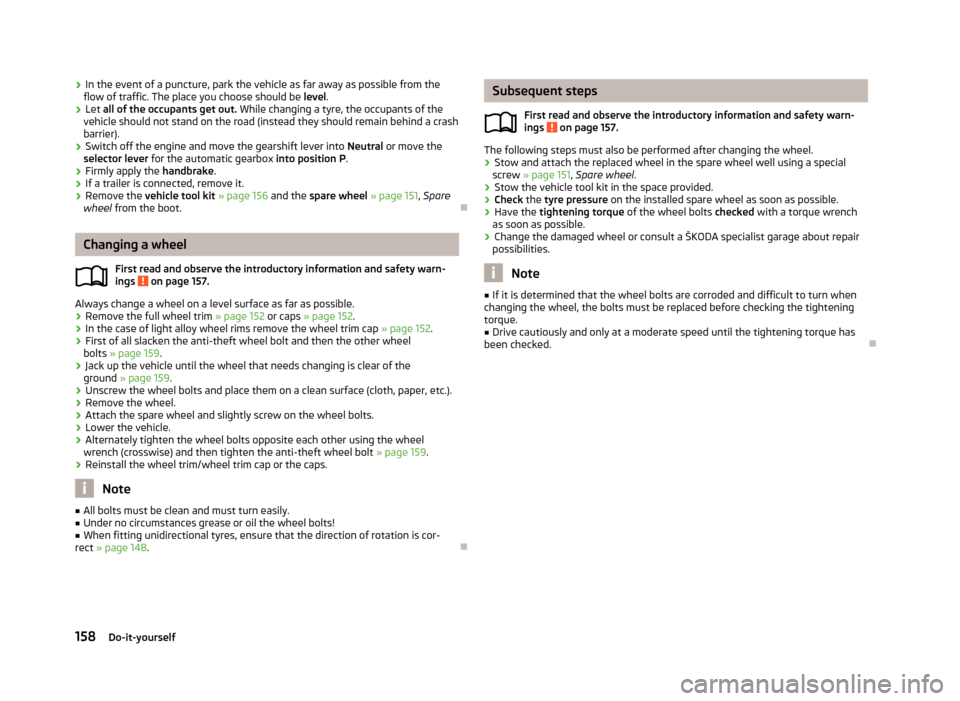
›
In the event of a puncture, park the vehicle as far away as possible from the
flow of traffic. The place you choose should be level.
› Let all of the occupants get out.
While changing a tyre, the occupants of the
vehicle should not stand on the road (instead they should remain behind a crash
barrier).
› Switch off the engine and move the gearshift lever into
Neutral or move the
selector lever for the automatic gearbox into position P .
› Firmly apply the
handbrake.
› If a trailer is connected, remove it.
› Remove the vehicle tool kit
» page 156 and the spare wheel » page 151, Spare
wheel from the boot. ÐChanging a wheel
First read and observe the introductory information and safety warn-
ings on page 157.
Always change a wheel on a level surface as far as possible.
›
Remove the full wheel trim
» page 152 or caps » page 152.
› In the case of light alloy wheel rims remove the wheel trim cap
» page 152.
› First of all slacken the anti-theft wheel bolt and then the other wheel
bolts » page 159.
› Jack up the vehicle until the wheel that needs changing is clear of the
ground » page 159.
› Unscrew the wheel bolts and place them on a clean surface (cloth, paper, etc.).
› Remove the wheel.
› Attach the spare wheel and slightly screw on the wheel bolts.
› Lower the vehicle.
› Alternately tighten the wheel bolts opposite each other using the wheel
wrench (crosswise) and then tighten the anti-theft wheel bolt » page 159.
› Reinstall the wheel trim/wheel trim cap or the caps. Note
■ All bolts must be clean and must turn easily.
■ Under no circumstances grease or oil the wheel bolts!
■ When fitting unidirectional tyres, ensure that the direction of rotation is cor-
rect »
page 148 . Ð
ä Subsequent steps
First read and observe the introductory information and safety warn-
ings on page 157.
The following steps must also be performed after changing the wheel.
›
Stow and attach the replaced wheel in the spare wheel well using a special
screw » page 151, Spare wheel.
› Stow the vehicle tool kit in the space provided.
› Check
the tyre pressure
on the installed spare wheel as soon as possible.
› Have the
tightening torque of the wheel bolts checked with a torque wrench
as soon as possible.
› Change the damaged wheel or consult a ŠKODA specialist garage about repair
possibilities. Note
■ If it is determined that the wheel bolts are corroded and difficult to turn when
changing the wheel, the bolts must be replaced before checking the tightening
torque. ■ Drive cautiously and only at a moderate speed until the tightening torque has
been checked. Ð
ä
158 Do-it-yourself
Page 186 of 194
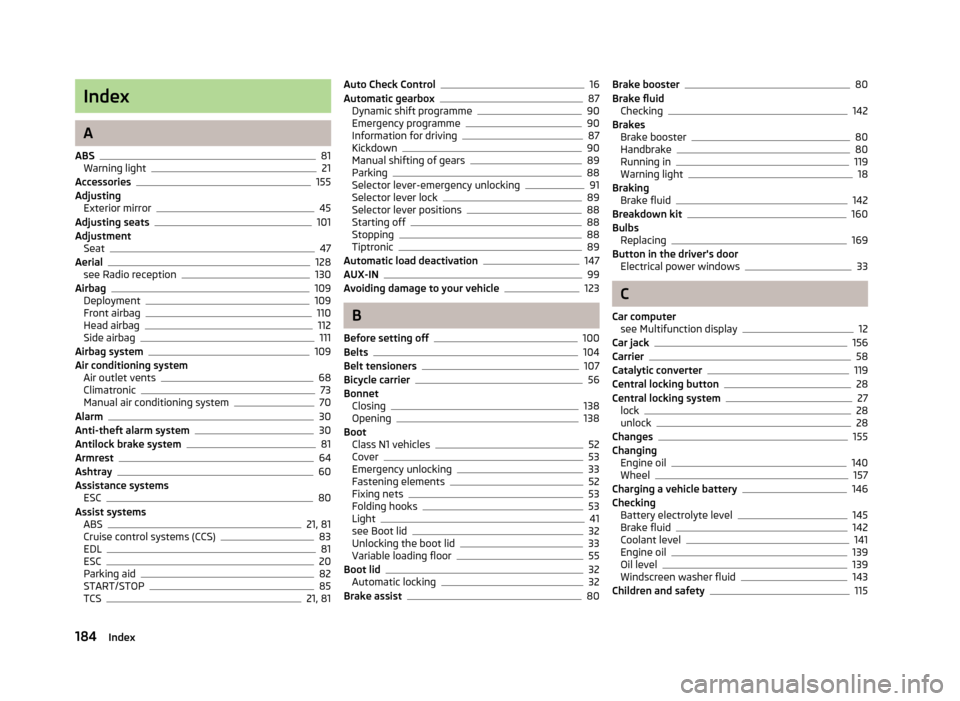
Index
A
ABS 81
Warning light 21
Accessories 155
Adjusting Exterior mirror 45
Adjusting seats 101
Adjustment Seat 47
Aerial 128
see Radio reception 130
Airbag 109
Deployment 109
Front airbag 110
Head airbag 112
Side airbag 111
Airbag system 109
Air conditioning system Air outlet vents 68
Climatronic 73
Manual air conditioning system 70
Alarm 30
Anti-theft alarm system 30
Antilock brake system 81
Armrest 64
Ashtray 60
Assistance systems ESC 80
Assist systems ABS 21, 81
Cruise control systems (CCS) 83
EDL 81
ESC 20
Parking aid 82
START/STOP 85
TCS 21, 81Auto Check Control 16
Automatic gearbox 87
Dynamic shift programme 90
Emergency programme 90
Information for driving 87
Kickdown 90
Manual shifting of gears 89
Parking 88
Selector lever-emergency unlocking 91
Selector lever lock 89
Selector lever positions 88
Starting off 88
Stopping 88
Tiptronic 89
Automatic load deactivation 147
AUX-IN 99
Avoiding damage to your vehicle 123
B
Before setting off 100
Belts 104
Belt tensioners 107
Bicycle carrier 56
Bonnet Closing 138
Opening 138
Boot Class
N1 vehicles 52
Cover 53
Emergency unlocking 33
Fastening elements 52
Fixing nets 53
Folding hooks 53
Light 41
see Boot lid 32
Unlocking the boot lid 33
Variable loading floor 55
Boot lid 32
Automatic locking 32
Brake assist 80Brake booster 80
Brake fluid Checking 142
Brakes Brake booster 80
Handbrake 80
Running in 119
Warning light 18
Braking Brake fluid 142
Breakdown kit 160
Bulbs Replacing 169
Button in the driver's door Electrical power windows 33
C
Car computer see Multifunction display 12
Car jack 156
Carrier 58
Catalytic converter 119
Central locking button 28
Central locking system 27
lock 28
unlock 28
Changes 155
Changing Engine oil 140
Wheel 157
Charging a vehicle battery 146
Checking Battery electrolyte level 145
Brake fluid 142
Coolant level 141
Engine oil 139
Oil level 139
Windscreen washer fluid 143
Children and safety 115
184 Index
Page 187 of 194
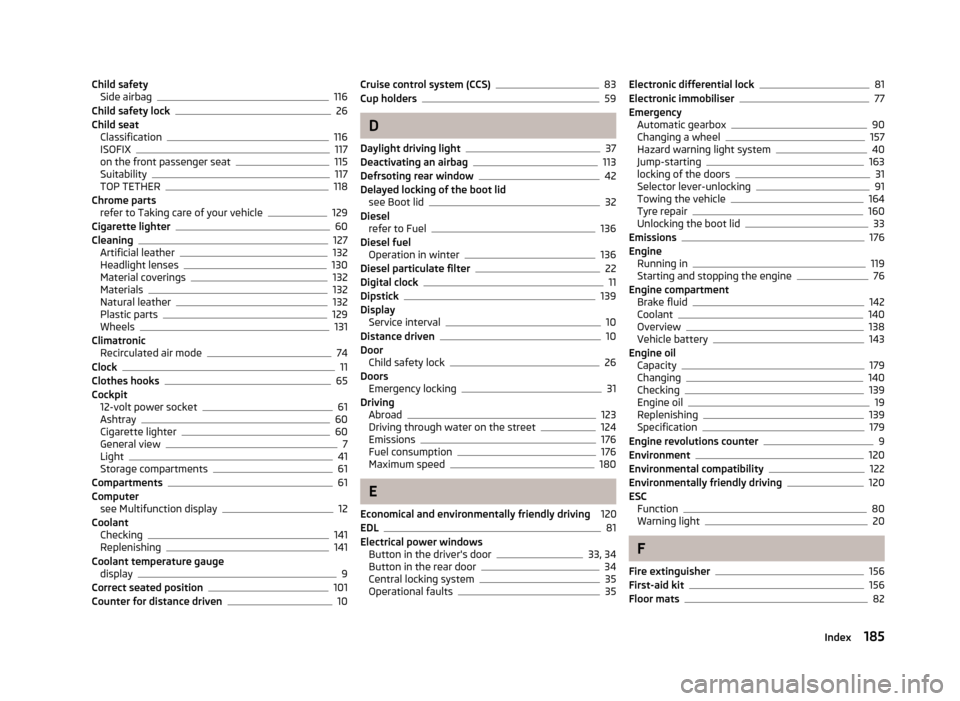
Child safety
Side airbag 116
Child safety lock 26
Child seat Classification 116
ISOFIX 117
on the front passenger seat 115
Suitability 117
TOP TETHER 118
Chrome parts refer to Taking care of your vehicle 129
Cigarette lighter 60
Cleaning 127
Artificial leather 132
Headlight lenses 130
Material coverings 132
Materials 132
Natural leather 132
Plastic parts 129
Wheels 131
Climatronic Recirculated air mode 74
Clock 11
Clothes hooks 65
Cockpit 12-volt power socket 61
Ashtray 60
Cigarette lighter 60
General view 7
Light 41
Storage compartments 61
Compartments 61
Computer see Multifunction display 12
Coolant Checking 141
Replenishing 141
Coolant temperature gauge display 9
Correct seated position 101
Counter for distance driven 10Cruise control system (CCS) 83
Cup holders 59
D
Daylight driving light 37
Deactivating an airbag 113
Defrsoting rear window 42
Delayed locking of the boot lid see Boot lid 32
Diesel refer to Fuel 136
Diesel fuel Operation in winter 136
Diesel particulate filter 22
Digital clock 11
Dipstick 139
Display Service interval 10
Distance driven 10
Door Child safety lock 26
Doors Emergency locking 31
Driving Abroad 123
Driving through water on the street 124
Emissions 176
Fuel consumption 176
Maximum speed 180
E
Economical and environmentally friendly driving 120
EDL 81
Electrical power windows Button in the driver's door 33, 34
Button in the rear door 34
Central locking system 35
Operational faults 35Electronic differential lock 81
Electronic immobiliser 77
Emergency Automatic gearbox 90
Changing a wheel 157
Hazard warning light system 40
Jump-starting 163
locking of the doors 31
Selector lever-unlocking 91
Towing the vehicle 164
Tyre repair 160
Unlocking the boot lid 33
Emissions 176
Engine Running in 119
Starting and stopping the engine 76
Engine compartment Brake fluid 142
Coolant 140
Overview 138
Vehicle battery 143
Engine oil Capacity 179
Changing 140
Checking 139
Engine oil 19
Replenishing 139
Specification 179
Engine revolutions counter 9
Environment 120
Environmental compatibility 122
Environmentally friendly driving 120
ESC Function 80
Warning light 20
F
Fire extinguisher 156
First-aid kit 156
Floor mats 82
185
Index